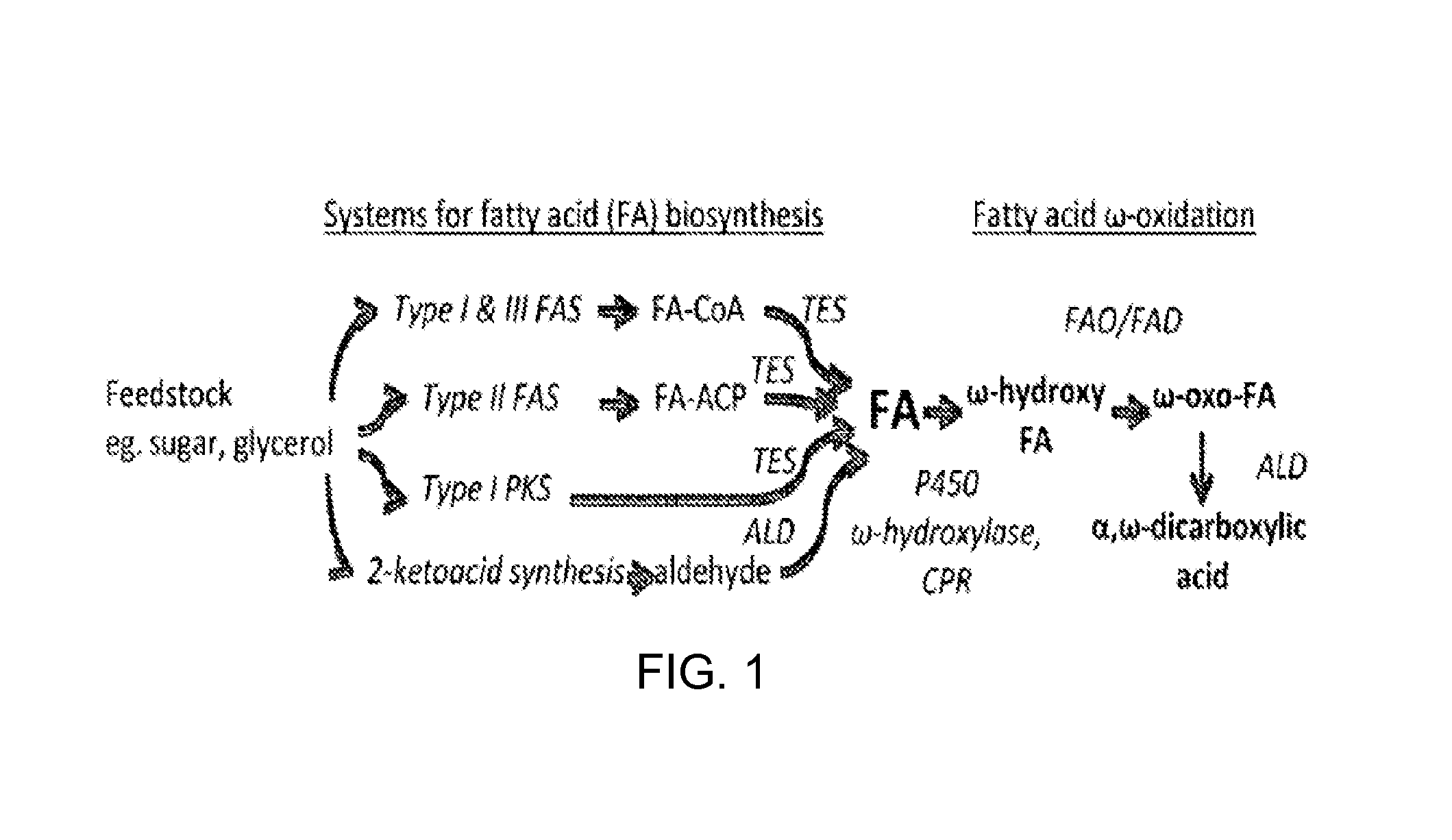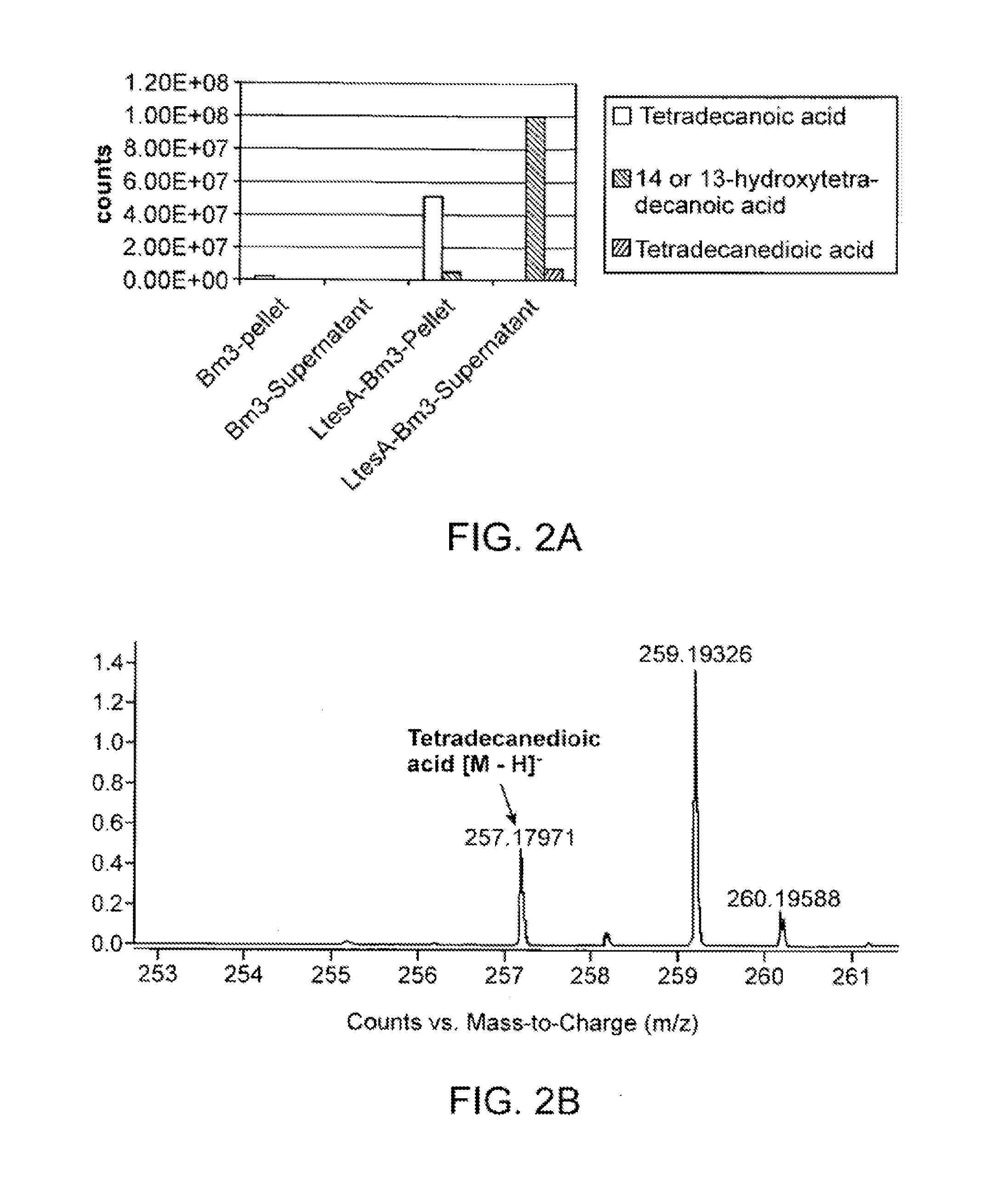Host Cells and Methods for Producing Diacid Compounds
- Summary
- Abstract
- Description
- Claims
- Application Information
AI Technical Summary
Benefits of technology
Problems solved by technology
Method used
Image
Examples
example 1
Production of Tetradecanedioic Acid
[0116]In accordance with various embodiments of the present invention, tetradecanedioic acid is produced. In one embodiment, a heterologous type III fatty acid synthase ELO1 and ELO2 (T. brucei) are expressed in conjunction with a set of enzymes that encode for the production of butyryl-CoA, which in some embodiments include phaA, phaB, phaJ, ter, and a thioesterase, which in some embodiments are encoded by ltesA to produce tetradecanoic acid. The tetradecanoic acid is then converted through the alcohol and aldehyde intermediate into the diacid tetradecanedioic acid by expressing a P450 and FAO.
[0117]In another embodiment, a native type II FAS system and a thioesterase from E. coli that produces tetradecanoate were expressed in a host cell of the invention. Once produced, the tetradecanoate is further oxidized in accordance with the invention at the omega carbon by P450s. Although many thioesterases are suitable for these embodiments, in one embodi...
example 2
Production of Butanedioic Acid
[0120]In accordance with the methods of the invention, butanedioic is produced by a variety of embodiments. This example describes converting acetyl-CoA into butyryl-CoA, which is cleaved from the CoA by a thioesterase (TES), oxidized by a P450 monooxygenase (OX1) and further oxidized into its respective diacid by another oxidase (OX2). Importantly, a thioesterase can be engineered in accordance with the invention so that it cleaves hydroxybutyrate from its CoA, allowing for the production of 2-hydroxybutanedioic acid.
[0121]The above method is merely illustrative of the many embodiments provided by the invention. Another embodiment involves the use of a PKS composed of a loading module that incorporates malonyl-CoA an extension module and a TE that releases a butyrate product. In this embodiment, the fatty acid is then oxidized into omega hydroxybutyrate and finally into butanedioic acid. While many PKS modules can be used, in one embodiment, a malonyl-...
example 3
Production of Hexanedioic Acid
[0122]In accordance with various embodiments of the methods of the invention, hexanedioic acid is produced. In one embodiment, genes in the aflatoxin biosynthesis pathway that encode fatty acid biosynthesis reactions resulting in a final C6 fatty acid product, hexAB are used. Because others have reported that the hexanoic acid is bound to the hexAB enzyme3, in some embodiments, the hexAB has been mutated to decrease or eliminate such binding, and in other embodiments, a thioesterase (TES) is expressed that cleaves the C6 fatty acid from its thioester. In another embodiment, the transacylase from the PKS is used to load an ACP and subsequently cleave it with a TES. In another alternative embodiment, a short-chain thioesterase is engineered to directly produce the C6 fatty acid from type II fatty acid biosynthesis (see, e.g, Dehesh, et al., “Production of high levels of 8:0 and 10:0 fatty acids in transgenic canola by overexpression of Ch FatB2, a thioest...
PUM
| Property | Measurement | Unit |
|---|---|---|
| Acidity | aaaaa | aaaaa |
| Polymer chain length | aaaaa | aaaaa |
Abstract
Description
Claims
Application Information
 Login to View More
Login to View More - R&D
- Intellectual Property
- Life Sciences
- Materials
- Tech Scout
- Unparalleled Data Quality
- Higher Quality Content
- 60% Fewer Hallucinations
Browse by: Latest US Patents, China's latest patents, Technical Efficacy Thesaurus, Application Domain, Technology Topic, Popular Technical Reports.
© 2025 PatSnap. All rights reserved.Legal|Privacy policy|Modern Slavery Act Transparency Statement|Sitemap|About US| Contact US: help@patsnap.com



